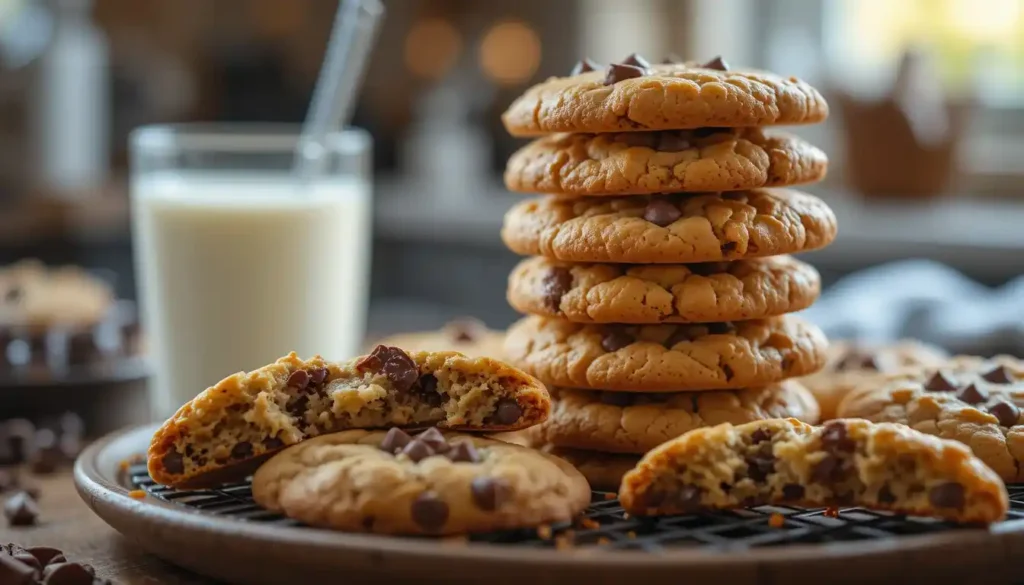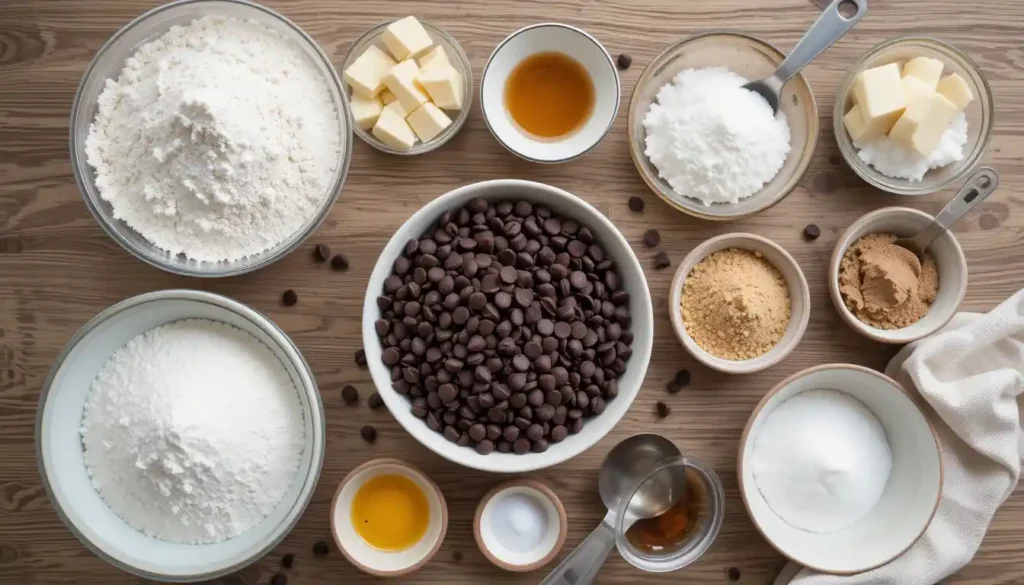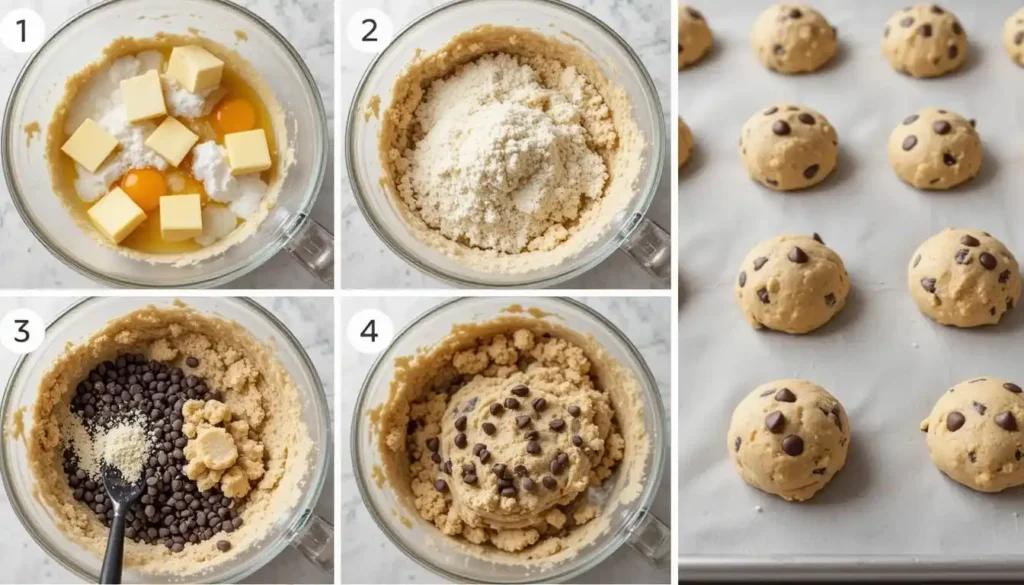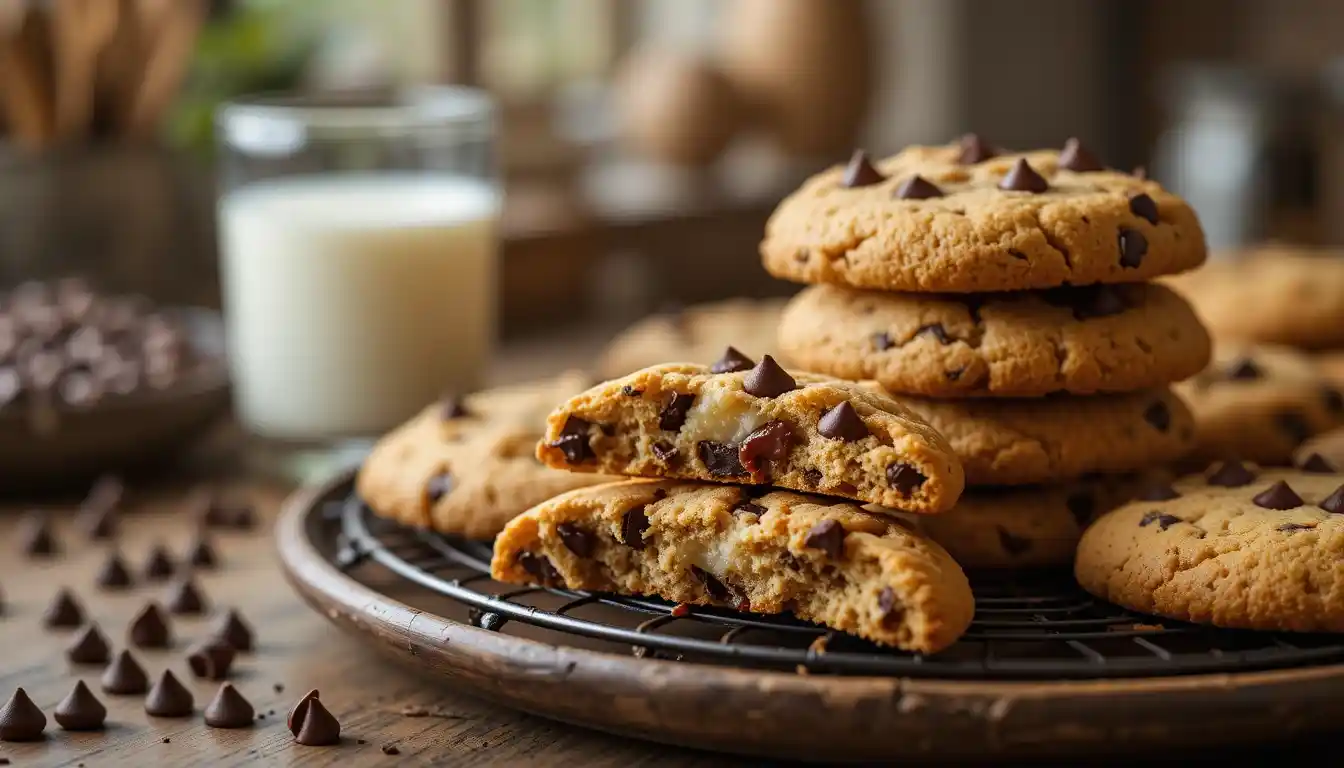Table of Contents
Are you tired of baking cookies that just don’t live up to your expectations? Do you dream of a recipe that yields perfectly cooked, doughy, and deliciously flavorful treats every time?
You’re not alone. The quest for the perfect chocolate chip cookie is a universal one. The good news is that you’ve found it. This guide will walk you through a straightforward, no-fuss recipe for baking the best cookies you’ve ever tasted.
This comprehensive guide covers everything from the essential ingredients to troubleshooting common issues, ensuring that bakers of all skill levels can achieve success. With this cookie recipe, you’ll learn not just how to bake, but also the science behind making them perfect.

The Perfect Chocolate Chip Cookie
The pursuit of the perfect chocolate chip cookie involves a deep dive into its history, ingredients, and baking techniques. To create the best chocolate chip cookies, one must understand what makes them great.
What Makes a Great Cookie
A great cookie is characterized by its crispy edges, soft center, balanced sweetness, and rich chocolate flavor. The texture plays a crucial role in cookie quality, with the ideal balance being between chewy and crispy. Proper ingredient ratios are essential for achieving the perfect cookie consistency.
| Characteristics | Description |
|---|---|
| Crispy Edges | Adds crunch and texture contrast |
| Soft Center | Provides chewiness and freshness |
| Balanced Sweetness | Ensures the cookie isn’t too sweet or bland |
| Rich Chocolate Flavor | Comes from high-quality chocolate chip ingredients |
The History Behind America’s Favorite Cookie
The chocolate chip cookie was invented by Ruth Wakefield in 1938 when she added chopped chocolate to her cookie dough at the Toll House Inn. Over the decades, the original recipe has evolved, but its core elements remain the same. Understanding the history of cookies helps bakers appreciate the classic elements that should be preserved.
The cultural significance of chocolate chip cookies in American homes and bakeries is undeniable. Different regions and bakeries have developed their own signature versions, but the essence remains the same: a perfect blend of crunch, chew, and chocolate flavor.
Essential Ingredients for Chocolate Chip Cookies
Crafting the perfect chocolate chip cookie begins with understanding the essential ingredients that make it delicious. The right combination of ingredients not only enhances the flavor but also affects the texture and overall quality of your cookies.

Butter: Salted vs. Unsalted
The choice between salted and unsalted butter can significantly impact your cookie’s flavor. Using salted butter, as in the provided recipe, adds a depth of flavor, but unsalted butter is also a viable option if you prefer to control the salt content separately. It’s recommended to taste the dough to ensure it’s salted to your liking.
Sugars: Brown vs. White
The type and proportion of sugar used play a crucial role in the cookie’s texture and spread. Using more brown sugar than white sugar results in a softer and chewier cookie due to its moisture content. Meanwhile, white granulated sugar contributes to the cookies’ crispness and spread.
Flour and Leavening Agents
The right type of flour and accurate measurement are vital for consistent results. Baking soda, a common leavening agent, helps in achieving the desired texture. The combination of flour and leavening agents like baking soda ensures your cookies have the perfect balance of texture and flavor.
Chocolate: Chips vs. Chunks
The choice between chocolate chips and chunks affects the final cookie experience. Chocolate chips provide a uniform chocolate distribution, while chunks offer larger, gooier chocolate bites. The choice depends on your preference for chocolate intensity in each bite.
Kitchen Tools You’ll Need
The right kitchen tools can make all the difference in baking delicious cookies. To ensure your recipe turns out perfectly, it’s essential to have the correct equipment.
Measuring Equipment
Accurate measurements are crucial in baking. You’ll need measuring cups (both dry and liquid) and measuring spoons to ensure your ingredients are precisely measured. This precision affects the consistency and quality of your cookies.
Mixing and Baking Tools
For mixing, you can use a simple wooden spoon or a stand mixer like a KitchenAid Mixer. A spatula is also necessary for scraping the sides of the bowl. For baking, you’ll need baking sheets (preferably 3) lined with parchment paper or a silicone baking mat. The type of baking sheet you use can affect your cookies; for instance, dark sheets can cause cookies to bake more quickly.
Optional but Helpful Tools
Some tools can make the baking process easier. A cookie scoop helps in achieving uniform cookies. A cooling rack is essential for cooling your baked goods properly. An oven thermometer ensures your oven is at the correct temperature, which is vital for successful baking. These tools can enhance your overall recipe outcome.
By equipping your kitchen with these tools, you’ll be well-prepared to tackle any cookie recipe, including this chocolate chip cookie one, and achieve great results.
Chocolate Chip Cookie Recipe
Making the best chocolate chip cookies starts with this simple yet detailed chocolate chip cookie recipe. Whether you’re a novice baker or an experienced one, this recipe is designed to yield perfect cookies every time.
Ingredients List
To make these delicious cookies, you’ll need the following ingredients:
- 1 cup salted butter, softened (226g)
- 1 cup granulated sugar (200g)
- 1 cup light brown sugar, packed (220g)
- 2 teaspoons pure vanilla extract
- 2 large eggs
- 3 cups all-purpose flour (375g)
- 1 teaspoon baking soda
- ½ teaspoon baking powder
- 1 teaspoon sea salt
- 2 cups chocolate chips (12 oz or 340g)
Nutritional Information
Each cookie serving contains:
- Calories: 183kcal
- Carbohydrates: 26g
- Protein: 2g
- Fat: 8g
- Saturated Fat: 5g
- Cholesterol: 27mg
- Sodium: 153mg
- Potassium: 31mg
- Fiber: 1g
- Sugar: 18g
- Vitamin A: 197IU
- Vitamin C: 1mg
- Calcium: 24mg
- Iron: 1mg
Preparation Time
The total preparation time for this recipe is approximately 20 minutes, with an additional 30 minutes for chilling the dough. Baking time is around 10-12 minutes per batch.
Yield Information
This chocolate chip cookie recipe yields approximately 24-30 cookies, depending on the size of the cookie scoop used.
Dietary Considerations
This recipe contains common allergens such as gluten, dairy, and eggs. To adapt it for dietary restrictions:
- For gluten-free cookies, substitute the all-purpose flour with a gluten-free flour blend.
- For dairy-free cookies, use vegan butter and dairy-free chocolate chips.
- For vegan cookies, replace eggs with a flax egg and use vegan butter.
Using high-quality ingredients will significantly impact the final outcome of your cookies, making them taste richer and more flavorful.
Step-by-Step Preparation Instructions
Let’s dive into the step-by-step guide to making the best chocolate chip cookies. Preparing your ingredients and mixing the dough are crucial steps that require attention to detail.

Preparing Your Ingredients
Before you start mixing, make sure all your ingredients are at room temperature. This is particularly important for butter and eggs, as it ensures they cream together smoothly and evenly. For dry ingredients like flour, use the spoon and level method to measure accurately. This prevents packing the flour, which can lead to tough cookies.
Mixing the Dough
Cream together butter and sugar until they’re well combined. The mixture should be light and fluffy. Next, beat in eggs and vanilla extract until the mixture is smooth and light, about 1 minute. Then, mix in the dry ingredients until just combined, being careful not to overmix. Finally, add chocolate chips and mix well to distribute them evenly throughout the cookie dough.
Chilling the Dough: Why It Matters
Chilling the dough is a critical step that shouldn’t be skipped. It allows the flavors to meld together and the butter to firm up, resulting in cookies that retain their shape better while baking. Cold dough means thicker, chewier cookies. So, unless you want your cookies to spread into a massive cookie puddle, chilling is mandatory.
Shaping Your Cookies
Once the dough is chilled, it’s time to shape your cookies. Use a cookie scoop or spoon to portion out the dough into balls. The size and shape of these balls will affect the final texture and appearance of your cookies. For uniform baking, try to make the balls as consistent as possible. This step is crucial for achieving that perfect, bakery-style cookie.
Baking Your Chocolate Chip Cookies
To achieve the ideal chocolate chip cookies, understanding the baking process is crucial. This involves not just following a recipe, but also mastering the techniques that ensure your cookies turn out perfectly every time.
Oven Temperature and Positioning
Preheating your oven to the correct temperature is vital for baking consistent cookies. Ensure your oven is at 375 degrees F before you start baking. The positioning of your baking sheets also matters; typically, the middle rack is the best position for even baking. This helps in achieving a uniform color and texture across your cookies.
Baking Time: Signs of Doneness
Bake your cookies in the preheated oven for approximately 8-10 minutes. The key to perfectly baked cookies is to remove them from the oven when they are just barely starting to turn brown. It’s crucial not to over-bake; your cookies should look slightly underdone when you take them out. This ensures they retain their chewiness.
| Baking Time | Signs of Doneness |
|---|---|
| 8-10 minutes | Just starting to turn brown |
| Over 10 minutes | Golden brown, might be too crispy |
Cooling Process
After baking, let your cookies sit on the baking sheet for 5 minutes. This initial cooling is crucial as it allows the cookies to set. Then, transfer them to a cooling rack to cool completely. This step is important because the cookies continue to bake on the hot sheet after being removed from the oven. Proper cooling affects the final texture, preventing cookies from becoming too crisp or breaking apart.
By following these steps, you’ll be able to bake chocolate chip cookies that are not only delicious but also have the perfect texture. Remember, the key is in the details: preheating your oven correctly, not over-baking, and cooling your cookies properly.
The Science Behind Perfect Chocolate Chip Cookies
To bake the perfect chocolate chip cookies, it’s essential to grasp the science that governs their creation. The process involves a complex interplay of ingredients and techniques that ultimately determine the texture and flavor of your cookies.
How Ingredients Interact
The interaction between ingredients is crucial in determining the final product. For instance, using melted butter can produce chewier cookies, but it can also make them greasy if not balanced with enough flour. The moisture in brown sugar contributes to a soft and chewy texture, while white granulated sugar helps cookies spread during baking. The proteins in flour (gluten) interact with liquids and fats to create structure in cookies. Different sugars affect moisture retention, crystallization, and browning. The Maillard reaction, a chemical reaction between amino acids and reducing sugars, occurs when cookies are baked, creating their characteristic flavor and color.
| Ingredient | Role in Cookies |
|---|---|
| Butter | Contributes to chewiness and flavor |
| Brown Sugar | Adds moisture and tenderness |
| White Granulated Sugar | Helps cookies spread and browns cookies |
| Flour | Provides structure through gluten development |
The Role of Temperature
Temperature control is vital throughout the cookie-making process. The temperature of your ingredients, particularly butter, affects the dough consistency. Cold ingredients can lead to a cookie that retains its shape, while room temperature ingredients can result in a spreadier cookie. The oven temperature impacts the spread rate, texture development, and overall cookie structure. Proper baking temperature ensures that cookies are cooked evenly, achieving the desired texture and color.
By understanding how ingredients interact and the role of temperature, you can refine your cookie-baking technique to achieve perfect chocolate chip cookies every time.
Troubleshooting Common Cookie Problems
Troubleshooting common cookie problems is essential for achieving perfect results. Even with a precise chocolate chip cookie recipe, issues can arise during baking. Understanding the causes of these problems and knowing how to fix them can make a significant difference in your baking.
Why Cookies Spread Too Much
Cookies spreading too much during baking can be frustrating. This issue often results from warm butter, insufficient flour, or old leavening agents. To prevent excessive spreading, ensure your butter is at the right temperature, measure your flour accurately, and check the expiration date of your baking soda. Chilling your dough can also help control spread.
Dealing with Cookies That Don’t Flatten
Sometimes, cookies don’t flatten enough, which can be due to too much flour, cold dough, or an oven temperature that’s too low. To achieve the right texture, ensure you’re measuring your ingredients correctly, and consider letting your dough sit at room temperature for a bit before baking. Slightly flattening the dough balls before baking can also help.
Fixing Overly Hard or Soft Cookies
The texture of your cookies can be a giveaway to their quality. Cookies that turn out too hard may be overbaked or have too little butter or sugar. To fix this, try reducing your baking time or adding a bit more fat or sugar to your recipe. On the other hand, cookies that are too soft might be underbaked or have too much moisture. Adjusting your baking time or reducing the moisture content can help achieve the perfect texture.
| Issue | Cause | Solution |
|---|---|---|
| Cookies spread too much | Warm butter, insufficient flour, old leavening agents | Chill dough, measure flour accurately, check baking soda expiration |
| Cookies don’t flatten | Too much flour, cold dough, low oven temperature | Measure ingredients correctly, let dough sit at room temperature, flatten dough balls |
| Cookies too hard | Overbaking, too little butter or sugar | Reduce baking time, add more fat or sugar |
| Cookies too soft | Underbaking, too much moisture | Adjust baking time, reduce moisture content |
By understanding these common issues and their solutions, you can improve your cookie-baking skills and achieve consistent results. Remember, the key to perfect cookies lies in the details of your preparation and baking process.
Tips for Achieving Bakery-Style Cookies
The secret to making cookies that taste like they were baked in a professional bakery lies in the details. To achieve that perfect cookie, you need to focus on both the texture and the appearance. Using a cookie scoop ensures that your cookies are uniform in size, which is crucial for even baking. Additionally, the way you shape your cookie dough balls can significantly impact the final texture and look of your cookies.
Creating the Perfect Texture
To create cookies with the perfect texture, it’s essential to achieve a balance between crispy edges and a soft, chewy center. Slightly underbaking your cookies can help you attain this balance. Moreover, using the right technique when shaping your dough balls can contribute to the desired texture. Rolling the dough into tall, lumpy balls rather than smooth, wide ones gives the cookies a thicker, more bakery-like texture.
Achieving That Professional Look
Achieving a professional look for your cookies involves a few simple techniques. Using a cookie scoop helps in maintaining uniformity, which is a hallmark of bakery-style cookies. Additionally, adding extra chocolate chips on top of the cookies immediately after baking not only adds to the visual appeal but also enhances the flavor. Creating attractive cracks and ridges on the surface by not overworking the dough and not flattening the dough balls too much also contributes to that artisanal look.
Variations on the Classic Chocolate Chip Cookie
Chocolate chip cookies are a canvas waiting for your creativity, whether you’re adding nuts, changing up the chocolate, or trying new spices. The classic recipe is a great starting point, but experimenting with different ingredients can lead to exciting new flavors and textures. You can easily adapt this beloved treat to suit various tastes and dietary needs.
Add-In Options
One of the simplest ways to vary your chocolate chip cookies is by adding different mix-ins. Beyond standard chocolate chips, you can explore other options like nuts (walnuts or pecans work well), dried fruits, or candy pieces. When adding new mix-ins, consider the ratio to maintain the cookie’s structure; for instance, if you’re adding nuts, you might slightly decrease the amount of chocolate chips to balance the flavor.
For example, adding peanut butter chips can introduce a delightful flavor contrast. You can also try different types of chocolate, like dark or white chocolate, for a unique twist.
Dietary Adaptations
To accommodate common dietary restrictions, you can make several adaptations to the classic cookie recipe. For a gluten-free version, substitute the flour with a gluten-free blend. If you’re catering to dairy-free or vegan diets, consider using plant-based butter and non-dairy chocolate chips. These substitutions can help ensure that everyone can enjoy your delicious cookies.
Flavor Twists
Transforming the basic chocolate chip cookie recipe with new flavors can be incredibly fun. Try adding spices like cinnamon or nutmeg for a warm twist, or incorporate extracts like vanilla or almond to deepen the flavor. You can also experiment with zests, like orange or lemon, to add a bright, citrusy note to your cookies. For a gourmet touch, consider browning the butter or using specialty chocolates.
Storing Your Chocolate Chip Cookies
The right storage method can significantly extend the freshness of your chocolate chip cookies. Proper storage ensures that your cookies remain delicious for as long as possible.
Room Temperature Storage
Store your chocolate chip cookies in an airtight container at room temperature for up to 5 days. To prevent cookies from sticking together, layer them with parchment paper.
Refrigerator Storage
Refrigerating your cookies can affect their texture, making them harder. If you choose to refrigerate, wrap the cookies tightly in plastic wrap or aluminum foil to maintain freshness.
Freezing Baked Cookies
For longer storage, consider freezing your baked cookies. Wrap them individually in plastic wrap or aluminum foil and place them in a freezer-safe bag or container to prevent freezer burn.
Freezing Cookie Dough
Freezing cookie dough is a great way to have fresh cookies whenever you want. Flash-freeze the dough balls on a baking sheet, then transfer them to an airtight container or freezer-safe bag for storage. This method allows you to bake fresh cookies in the future.
| Storage Method | Duration | Notes |
|---|---|---|
| Room Temperature | Up to 5 days | Store in airtight container, layer with parchment |
| Refrigerator | Up to 7 days | Wrap tightly, affects texture |
| Freezer (Baked Cookies) | Up to 2 months | Wrap individually, prevent freezer burn |
| Freezer (Cookie Dough) | Up to 2 months | Flash-freeze dough balls, store in airtight container |
By following these storage tips, you can enjoy your chocolate chip cookies over a longer period while maintaining their quality.
Make-Ahead Options
The convenience of preparing cookie dough ahead of time cannot be overstated. Whether you’re planning for a party, a bake sale, or just a sweet treat for later, having cookie dough ready to go is a significant advantage.
Preparing Dough in Advance
Preparing your chocolate chip cookie dough in advance not only saves time but also enhances the flavor. When you refrigerate the dough for up to 3 days, the ingredients meld together, resulting in a richer taste. To store, simply place the dough in an airtight container in the refrigerator.
Baking from Frozen Dough
For longer storage, freezing the dough is an excellent option. You can freeze the dough balls on a baking sheet, then transfer them to a freezer-safe bag or container for up to 3 months. When you’re ready to bake, you have two options: thawing the dough balls first or baking them directly from frozen. If you choose to thaw, let them sit at room temperature for about 1-2 hours before baking as directed. For baking from frozen, preheat your oven to 350°F, place the frozen dough balls on a parchment-lined baking sheet, and bake for 15 minutes.
| Storage Method | Duration | Benefits |
|---|---|---|
| Refrigerator | Up to 3 days | Enhances flavor, convenient for short-term use |
| Freezer | Up to 3 months | Ideal for longer storage, perfect for unexpected guests or cravings |
Serving Suggestions
Elevate your chocolate chip cookie experience with these serving suggestions. The right accompaniments can transform a simple cookie into a delightful treat.
Pairing with Beverages
Pairing your chocolate chip cookies with the right beverage can enhance their flavor. A glass of cold milk is a classic combination, but you can also experiment with different types of milk such as almond or oat milk. For adults, consider pairing cookies with coffee, tea, or even wine at gatherings. Serving warm cookies with a melty chocolate center alongside a cold glass of milk is a match made in heaven.
Creating Cookie Desserts
Transform your cookies into elaborate desserts with a few creative ideas. Use chocolate chip cookies as the base for ice cream sandwiches by sandwiching your favorite ice cream between two cookies. You can also create cookie sundaes by topping a cookie with ice cream, hot fudge, and whipped cream. Another idea is to use crushed cookies as a crust for cheesecakes or pies. For a cookie trifle, layer cookies with whipped cream and chocolate sauce for a show-stopping dessert.
| Dessert Idea | Description |
|---|---|
| Ice Cream Sandwiches | Use cookies as the ‘buns’ for your favorite ice cream |
| Cookie Sundae | Top a cookie with ice cream, hot fudge, and whipped cream |
| Cookie Crust | Crush cookies to make a crust for cheesecakes or pies |
Why This Chocolate Chip Cookie Recipe Works
The success of this chocolate chip cookie recipe can be attributed to a combination of science-backed techniques and precise ingredient ratios. The result is a cookie that is both soft and chewy, with a rich chocolate flavor.
Key Techniques That Make a Difference
Several key techniques contribute to the success of this chocolate chip cookie recipe. Firstly, melting the butter before mixing it with other ingredients helps to create a chewier texture. Additionally, using more brown sugar than white sugar enhances the moisture content of the cookies. The inclusion of cornstarch also plays a crucial role in achieving the perfect texture.
- Melting butter for a chewier texture
- Using more brown sugar for enhanced moisture
- Incorporating cornstarch for the perfect texture
- Chilling the dough to prevent over-spreading
Reader Success Stories
Readers have had tremendous success with this cookie recipe, with many praising the cookies as the best they’ve ever had. One reader, Adrienne, commented: “These are the best cookies I’ve ever had. Incredible. Don’t cut corners or you’ll miss out. Do everything she says and you’re in for the best cookies of your life. ★★★★★”
“I’ve made these cookies multiple times, and they always turn out perfectly. The addition of cornstarch really makes a difference!”
The specific ratio of ingredients and the method of preparation, including chilling the dough, contribute significantly to the final result. By following this recipe, you can achieve bakery-style cookies at home with minimal effort.
Frequently Asked Questions About Chocolate Chip Cookies
Baking chocolate chip cookies can raise several questions, from ingredient substitutions to baking techniques. Here are some answers to common queries that can help you perfect your chocolate chip cookie recipe.
Ingredient Substitutions
One of the most common questions is about substituting ingredients. For instance, you can easily halve this recipe by decreasing the ingredients by half, resulting in 18 delicious cookies. If you’re looking to add some crunch, you can introduce nuts like walnuts or pecans into your cookies; just be sure to slightly reduce the amount of chocolate chips to accommodate the extra ingredients.
When it comes to flour, it’s worth noting that 1 cup of flour typically weighs between 130-140 grams when measured by scooping and leveling, not the often-quoted 120 grams. You can also experiment with different types of flour, such as gluten-free options, though this may affect the texture of your cookies.
Baking Adjustments
Adjusting the recipe for different conditions is another frequent concern. For high altitudes or varying humidity levels, you may need to tweak your cookie recipe. Additionally, when making larger or smaller batches, ensure you adjust the baking time accordingly to achieve the perfect bake.
Troubleshooting Questions
If your cookies are spreading too much, it might be due to the butter being too soft or the baking soda not being fresh. Conversely, if they’re not spreading enough, your butter might be too cold. Ensuring your ingredients are at room temperature and using the right flour can make a significant difference.
For issues like cookies being too hard or too soft, check your baking time and temperature. Make sure to store your cookies properly to maintain freshness, and consider freezing cookie dough for future batches.
Conclusion
As we wrap up this comprehensive guide, it’s clear that baking the perfect chocolate chip cookie is an art that combines technique, quality ingredients, and a dash of love. Throughout this article, we’ve explored the essential ingredients, techniques, and tips necessary for creating exceptional cookies.
Understanding the role of each ingredient and the science behind the baking process is crucial. Remember, the quality of your chocolate chip cookies depends on the quality of your ingredients and your attention to detail during preparation.
Don’t be afraid to experiment with variations of this classic cookie recipe. Try different types of chocolate or add-ins to create your unique flavor. Most importantly, enjoy the process and share your creations with others.
Baking chocolate chip cookies from scratch is a labor of love that brings joy to both the baker and those who get to enjoy the fruits of their labor. As my motto goes, “Life is too uncertain to take a minute for granted. Spread love, make cookies.” I encourage you to share your cookie baking experiences and adaptations, and explore other related recipes to continue your culinary journey.
By sharing homemade cookies, we create meaningful connections and memories. Happy baking!
FAQ
What is the best type of sugar to use for soft and chewy cookies?
Using a combination of white and brown sugar helps achieve a soft and chewy texture. Brown sugar contains more moisture, which contributes to the chewiness of the cookies.
Can I use salted butter instead of unsalted butter in cookie dough?
Yes, you can use salted butter, but you may want to reduce the amount of added salt in the recipe to avoid overly salty cookies. Unsalted butter is recommended for better control over the salt content.
Why is it important to chill the cookie dough before baking?
Chilling the dough allows the flour to hydrate and the butter to firm up, resulting in cookies that retain their shape better and have a more complex flavor.
How do I prevent cookies from spreading too much during baking?
To prevent excessive spreading, make sure to chill the dough, use the right baking soda, and avoid overmixing the dough. Also, ensure your baking sheet is at room temperature or use parchment paper.
Can I freeze baked cookies for later use?
Yes, you can freeze baked cookies for up to 3 months. Store them in an airtight container or freezer bag to maintain freshness. Simply thaw at room temperature when you’re ready to enjoy them.
How do I achieve a crisper cookie texture?
To achieve a crisper texture, bake the cookies for a slightly longer time or use a higher oven temperature. You can also try using less brown sugar and more white sugar.
Can I make cookie dough ahead of time and store it in the fridge or freezer?
Yes, you can prepare the dough in advance and store it in the fridge for up to 3 days or freeze the dough for up to 3 months. This allows for fresh-baked cookies whenever you want.


1 thought on “Chocolate Chip Cookie Recipe”
Comments are closed.